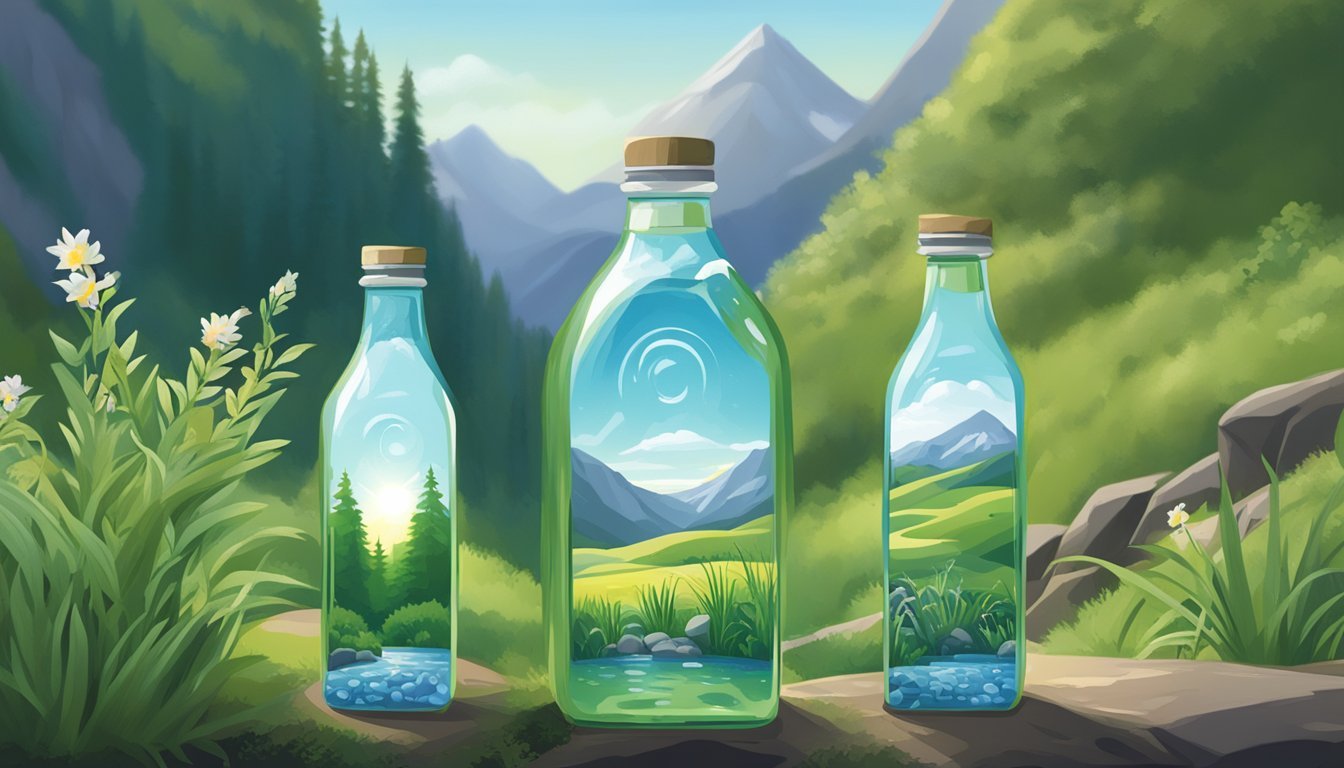Path vs. Defy
Which Bottled Water is Better? Full Comparison and Review
When it comes to choosing the right bottled water, Path and Defy are two brands that often come up in discussions. Both aim to offer something unique in the crowded bottled water market. PathWater is renowned for its sustainable approach, offering reusable aluminum bottles and promoting environmental responsibility. In contrast, Defy focuses on premium quality and taste, positioning itself as a luxury option in hydration.
For consumers looking for an eco-friendly choice, PathWater stands out due to its commitment to sustainability and reusability. It emphasizes reducing plastic waste by encouraging the use of its durable aluminum bottles. This makes it an attractive option for those who are environmentally conscious and want to reduce their carbon footprint.
Defy, on the other hand, appeals to those who prioritize taste and purity. Known for its rigorous filtration process and high-quality sources, Defy promises a refreshing and clean drinking experience. It is targeted towards individuals who are willing to pay a bit more for what they perceive as superior quality. Both brands bring distinct advantages to the table, catering to different consumer priorities and preferences.
The Fundamentals of Bottled Water
Bottled water comes in various types, each with distinct features and benefits. The manufacturing processes, brands, and quality standards of bottled water are crucial aspects to consider.
Understanding Bottled Water Types
There are several types of bottled water available, each catering to different preferences and needs. Spring water is collected from natural springs, while mineral water contains minerals naturally present in the source. Purified water undergoes processes like distillation or reverse osmosis to remove impurities. Alkaline water has a higher pH and is often marketed for its potential health benefits. Sparkling water is carbonated, offering a fizzy alternative to still water.
Manufacturing Processes and Brands
The manufacturing processes for bottled water vary depending on the type. For instance, purified water often undergoes advanced filtration and distillation to eliminate contaminants. Brands like Essentia specialize in producing high-quality alkaline water, known for its enhanced pH levels. Spring water brands source their product from protected springs, ensuring a natural taste. The industry also includes large multinational corporations and smaller niche brands, each employing unique purification techniques.
Water Quality and Standards
Water quality is paramount in the bottled water industry. The FDA regulates bottled water safety and labeling, while the EPA oversees tap water quality. Bottled water must meet stringent standards to ensure it’s safe for consumption. Regular testing for contaminants like bacteria, heavy metals, and chemicals is essential. High-quality brands often highlight their adherence to these standards, providing consumers with purity and safety assurances.
Health and Environmental Implications
Path and Defy, like all bottled waters, bear distinct considerations concerning health and the environment. Key aspects to evaluate include the safety of the drinking water, the impact of single-use plastics, and the benefits of reusable bottles over disposable ones.
Safety of Drinking Water
When considering Path and Defy, safety is paramount. Both brands likely meet stringent safety standards set by regulatory bodies. Bottled water usually undergoes rigorous testing to ensure it is free from contaminants.
In comparison, municipal water in many places is also subject to strict safety regulations. Advanced treatments and regular testing maintain safe drinking water standards.
Microplastics pose a significant concern. Studies report these particles in bottled water, raising questions about long-term health effects. Consumers should weigh the safety of reused plastics and consider brands transparent about their filtration and packaging processes.
Environmental Impact of Bottled Water
The environmental impact of bottled water is profound. Single-use plastic bottles are a major pollutant, contributing to oceans and landfills' growing plastic waste. Path and Defy must address their environmental footprint, particularly their use of recyclable or recycled materials.
Bottled water production consumes high energy and water resources. A study in Barcelona revealed the extensive costs and environmental toll of mass bottled water consumption. Switching to tap water significantly reduces this impact.
Choosing brands that prioritize sustainable practices, use low-impact packaging, and support recycling can mitigate some environmental concerns. Awareness of the carbon footprint and pollution generated by bottled water production is crucial for responsible consumption.
Reusable vs Single-Use Bottles
Path and Defy should ideally promote reusable bottles over single-use plastics. Reusable bottles greatly minimize plastic waste and environmental degradation. These bottles, often made from more durable and recyclable materials, lessen the burden on landfills and reduce pollution in ocean ecosystems.
Path and Defy can distinguish themselves by offering products designed for repeated use. Encouraging consumers to refill bottles with safe drinking water promotes sustainability and aligns with reducing plastic pollution objectives.
In contrast, single-use bottles, despite convenience, generate substantial waste and are less eco-friendly. Opting for reusable options is a proactive step towards environmental conservation.
Consumer Preferences and Lifestyle
Consumers prioritize various factors when selecting bottled water, including taste and packaging convenience. Trends in consumption and lifestyle choices influence which brands they prefer.
Trends in Water Consumption
In recent years, the market has seen a surge in bottled water consumption as consumers shift away from sugary beverages. The demand for pure and mineral-rich water has increased, making brands like Path and Defy more popular.
Water taste remains a crucial factor influencing consumer choices. Consumers debate between brands due to differences in taste and perceived health benefits. Path is often lauded for its crisp taste, while Defy is appreciated for its natural spring water flavor. Packaging also plays a significant role, especially in retail and airport settings where convenience is paramount.
Lifestyle and Reusability Choices
Modern consumers are environmentally conscious, often considering the reusability of water bottles. Path promotes its reusable aluminum bottles, appealing to eco-friendly consumers. These bottles are designed to reduce plastic waste and can be refilled multiple times.
Defy, on the other hand, offers biodegradable packaging, catering to those who prioritize sustainability. The choice between Path and Defy often depends on how individuals integrate water consumption into their lifestyle. Reusable bottles are favored by individuals who carry water throughout the day, while biodegradable packaging appeals to those looking for convenience without a long-term carry option.
Both brands cater to different lifestyle needs, offering unique solutions that align with consumer values around reusability and environmental impact.
Product Comparison and Analysis
Path and Defy, two prominent bottled water brands, stand out due to their distinct approaches to water quality, taste, and packaging. This section breaks down their brand characteristics, taste profiles, quality, price, and design considerations.
Path and Defy Brand Profiles
Path is known for its commitment to sustainable packaging, primarily using aluminum bottles. This approach is environmentally friendly and positions Path as a leader in reducing plastic waste. The custom Path bottles can be reused, aligning with eco-conscious consumer values.
Defy, in contrast, often employs more traditional packaging methods but emphasizes high-quality water sourced from pristine locations. Defy targets those who prioritize purity and performance, and the brand markets its water as being suitable for athletes and active individuals.
Taste Test Insights
Taste tests conducted by water sommeliers reveal nuanced differences between the two brands. Path water is praised for its crispness and a slightly alkaline taste, which some find refreshing, though there are remarks about a subtle metallic undertone due to the aluminum packaging.
Defy water, on the other hand, is celebrated for its smooth, clean flavor with a neutral pH balance. This makes it a preferred choice for consumers who enjoy a straightforward, pure taste without any aftertaste. Both brands have their loyal followers based on these taste preferences.
Quality and Price Evaluation
When it comes to quality, both Path and Defy emphasize purity, but they go about it differently. Path’s use of reusable bottles makes it an excellent choice for environmentally conscious consumers, while Defy’s focus on sourcing from natural springs ensures high mineral content and purity.
Price-wise, Path is slightly more expensive due to its innovative packaging and reusable nature. Defy offers a range of prices depending on the bottle type, with their standard plastic bottles being more affordable and their boxed water option catering to those seeking sustainable yet inexpensive choices.
Packaging and Design Considerations
Packaging is a significant differentiator between these brands. Path uses aluminum bottles, which are not only reusable but also keep the water cold for longer periods. This durable packaging appeals to consumers looking to reduce single-use plastic waste.
Defy offers a mix of single-use plastic bottles and boxed water, the latter being a more recent addition to align with sustainable trends. Their designs are sleek and practical, appealing to both casual consumers and athletes. The diversity in packaging options allows Defy to reach a broader market base.
Both brands have distinct advantages in this category. Path’s use of aluminum bottles exemplifies a strong commitment to sustainability, while Defy’s varied packaging offers flexibility and accessibility to different consumer needs.
The Future of Bottled Water
The bottled water industry shows no signs of slowing down as it continues to innovate and adapt to consumer demands and regulatory changes. The focus is on enhancing product quality and ensuring consumer safety.
Innovations and Market Trends
Manufacturers like Essentia, Aquafina, and Fiji are pioneering advancements in water purification and packaging technologies. Smartwater and Core Hydration are infusing electrolytes for added health benefits. Acqua Panna and Evian emphasize natural mineral content, while Icelandic Glacial focuses on the purity of source water.
Packaging is evolving, with many companies exploring environmentally friendly options. Voss and Flow are examples of brands using infinitely reusable bottles. Enhancements in sustainable packaging are critical as environmentally conscious consumers demand lower plastic waste solutions.
Market trends indicate a growing interest in alkaline and mineral-rich waters. Crystal Geyser and Dasani are seeing increased sales due to their purity and taste. Nestle and Arrowhead are investing in eco-friendly bottling and distribution to appeal to green consumers.
Regulations and Consumer Safety
In the United States, the Food and Drug Administration (FDA) regulates bottled water to ensure it meets strict safety standards. Brands like Aquafina and Dasani must undergo rigorous testing for contaminants. Compliance with FDA guidelines is crucial for manufacturers to maintain consumer trust and product quality.
Consumer safety also involves transparency in labeling. Evian and Essentia prominently display mineral content and source information, making it easier for consumers to make informed choices. Traceability is becoming a standard, with Crystal Geyser and Fiji providing detailed data on water sourcing and purification processes.
Future regulatory shifts may focus on stricter environmental protections and consumer safety measures. Companies are preparing to adapt by investing in clean technology and advanced filtration systems, ensuring their products are both safe and environmentally responsible.
More About Path
Mountain Valley Spring Water vs Path: Which Bottled Water is Better?
Path vs Whole Foods Italian Still Mineral water: Which Bottled Water is Better?



